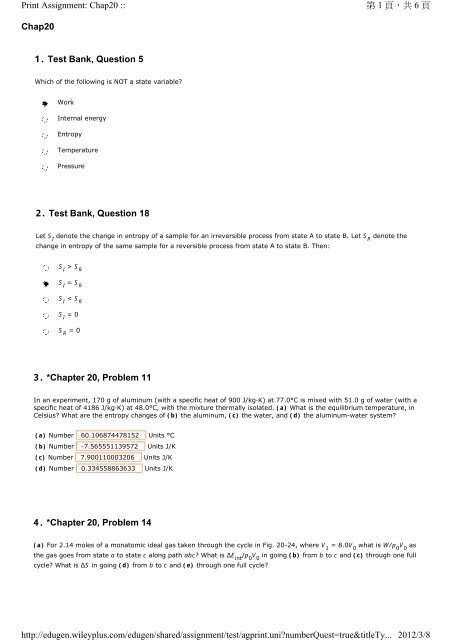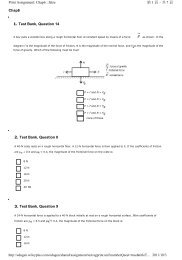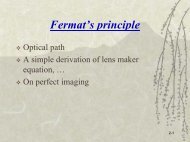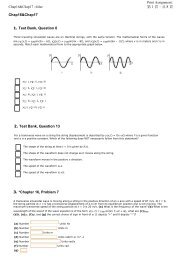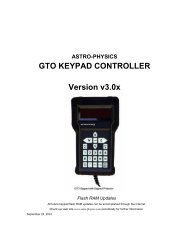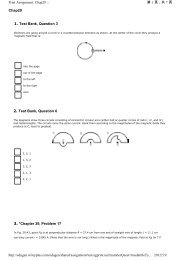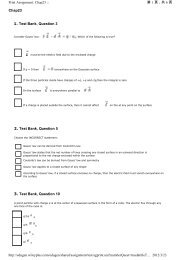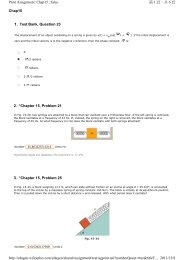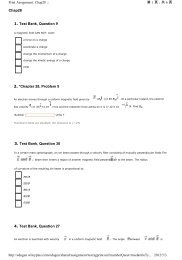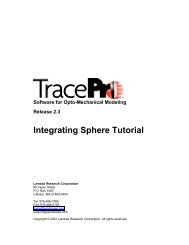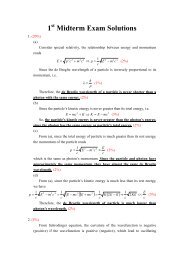Chap20 1. Test Bank, Question 5 2. Test Bank, Question 18 3 ...
Chap20 1. Test Bank, Question 5 2. Test Bank, Question 18 3 ...
Chap20 1. Test Bank, Question 5 2. Test Bank, Question 18 3 ...
- No tags were found...
You also want an ePaper? Increase the reach of your titles
YUMPU automatically turns print PDFs into web optimized ePapers that Google loves.
Print Assignment: <strong>Chap20</strong> ::http://edugen.wileyplus.com/edugen/shared/assignment/test/agprint.uni?numberQuest=true&titleTy...第 1 頁 , 共 6 頁2012/3/8<strong>Chap20</strong><strong>1.</strong> <strong>Test</strong> <strong>Bank</strong>, <strong>Question</strong> 5Which of the following is NOT a state variable?WorkInternal energyEntropyTemperaturePressure<strong>2.</strong> <strong>Test</strong> <strong>Bank</strong>, <strong>Question</strong> <strong>18</strong>Let S Idenote the change in entropy of a sample for an irreversible process from state A to state B. Let S Rdenote thechange in entropy of the same sample for a reversible process from state A to state B. Then:S I> S RS I= S RS I< S RS I= 0S R= 03. *Chapter 20, Problem 11In an experiment, 170 g of aluminum (with a specific heat of 900 J/kg·K) at 77.0°C is mixed with 5<strong>1.</strong>0 g of water (with aspecific heat of 4<strong>18</strong>6 J/kg·K) at 48.0°C, with the mixture thermally isolated. (a) What is the equilibrium temperature, inCelsius? What are the entropy changes of (b) the aluminum, (c) the water, and (d) the aluminum-water system?(a) Number 60.106874478152 Units °C(b) Number -7.565551139572 Units J/K(c) Number 7.900110003206 Units J/K(d) Number 0.334558863633 Units J/K4. *Chapter 20, Problem 14(a) For <strong>2.</strong>14 moles of a monatomic ideal gas taken through the cycle in Fig. 20-24, where V 1= 8.0V 0what is W/p 0V 0asthe gas goes from state a to state c along path abc? What is ΔE int/p 0V 0in going (b) from b to c and (c) through one fullcycle? What is ΔS in going (d) from b to c and (e) through one full cycle?
Print Assignment: <strong>Chap20</strong> ::http://edugen.wileyplus.com/edugen/shared/assignment/test/agprint.uni?numberQuest=true&titleTy...第 3 頁 , 共 6 頁2012/3/86. <strong>Test</strong> <strong>Bank</strong>, <strong>Question</strong> 21For all irreversible processes involving a system and its environment:the entropy of the system does not changethe entropy of the system increasesthe total entropy of the system and its environment does not changethe total entropy of the system and its environment increasesnone of the above7. <strong>Test</strong> <strong>Bank</strong>, <strong>Question</strong> 27According to the second law of thermodynamics:heat energy cannot be completely converted to workwork cannot be completely converted to heat energyfor all cyclic processes we have dQ/T < 0the reason all heat engine efficiencies are less than 100% is friction, which is unavoidableall of the above are true8. <strong>Test</strong> <strong>Bank</strong>, <strong>Question</strong> 30A heat engine operates between a high temperature reservoir at T Hand a low temperature reservoir at T L. Its efficiencyis given by 1 – T L/T H:only if the working substance is an ideal gasonly if the engine is reversibleonly if the engine is quasi-staticonly if the engine operates on a Stirling cycleno matter what characteristics the engine has9. *Chapter 20, Problem 33Figure 20-29 shows a reversible cycle through which <strong>1.</strong>00 mole of a monatomic ideal gas is taken. Process bc is anadiabatic expansion, with p b= 1<strong>1.</strong>0 atm and V b= 3.00 x 10 -3 m 3 . For the cycle, find (a) the energy added to the gas asheat, (b) the energy leaving the gas as heat, (c) the net work done by the gas, and (d) the efficiency of the cycle.
Print Assignment: <strong>Chap20</strong> ::http://edugen.wileyplus.com/edugen/shared/assignment/test/agprint.uni?numberQuest=true&titleTy...第 5 頁 , 共 6 頁2012/3/8<strong>2.</strong>22156Significant digits are disabled; the tolerance is +/-2%1<strong>2.</strong> *Chapter 20, Problem 52Suppose <strong>1.</strong>6 mol of a monatomic ideal gas initially at 6.3 L and 290 K is heated at constant volume to 590 K, allowed toexpand isothermally to its initial pressure, and finally compressed at constant pressure to its original volume, pressure,and temperature. During the cycle, what are (a) the net energy entering the system (the gas) as heat and (b) the network done by the gas? (c) What is the efficiency of the cycle?(a) Number 1156<strong>1.</strong>007947485059 Units J(b) Number 1583.641547485058 Units J(c) Number 0.136981269685 Units This answer has no units13. <strong>Test</strong> <strong>Bank</strong>, <strong>Question</strong> 35An inventor suggests that a house might be heated by using a refrigerator to draw energy as heat from the ground andreject energy as heat into the house. He claims that the energy supplied to the house can exceed the work required torun the refrigerator. This:is impossible by first lawis impossible by second lawwould only work if the ground and the house were at the same temperatureis impossible since heat flows from the (hot) house to the (cold) groundis possible14. *Chapter 20, Problem 64(a) A Carnot engine operates between a hot reservoir at 378 K and a cold one at 315 K. If the engine absorbs 575 J asheat per cycle at the hot reservoir, how much work per cycle does it deliver? (b) If the engine working in reversefunctions as a refrigerator between the same two reservoirs, how much work per cycle must be supplied to remove 339 Jas heat from the cold reservoir?
Print Assignment: <strong>Chap20</strong> ::http://edugen.wileyplus.com/edugen/shared/assignment/test/agprint.uni?numberQuest=true&titleTy...第 6 頁 , 共 6 頁2012/3/8(a) Number 95.833333333333 Units J(b) Number 67.8 Units J15. Chapter 20, Problem 75System A of three particles and system B of five particles are in insulated boxes like that in Figure 20-17. What is theleast multiplicity W of (a) system A and (b) system B? What is the greatest multiplicity W of (c)A and (d)B? What is thegreatest entropy of (e)A and (f)B?Fig. 20-17Problem 67.(a) Number 1 Units This answer has no units(b) Number 1 Units This answer has no units(c) Number 3 Units This answer has no units(d) Number 10 Units This answer has no units(e) Number <strong>1.</strong>516084958362E-23 Units J/K(f) Number 3.177567428332E-23 Units J/K


